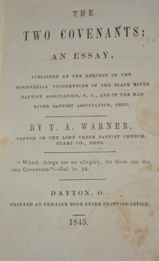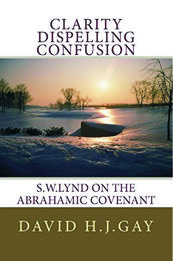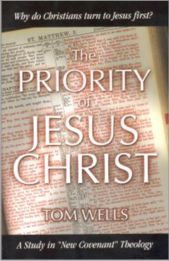Book Reviews by Heather
A Review of The Two Covenants by T. A. Warner
Reviewed by Heather A. Kendall

Search Inside this book
Second Printing: Tale2K; 101 pages (September 23, 2024) ISBN: 979-8339675976

First Printing: The City Book Store Printing Office, Dayton, OH (1845)
PDF version: Review of The Two Covenants
The Reason for This Review
T. A. Warner published The Two Covenants in 1845 at the request of The Black River Baptist Association in New York and The Mad River Baptist Association in Ohio. Warner had moved from New York to become the fifth pastor of the Lost Creek Baptist Church in Ohio. He must have presented this essay at both association meetings. Afterward both groups asked him to publish his work so that others could read it. Therefore, he asked the City Book Store Printing Office in Dayton, Ohio, to print some copies. I have no idea how many.
I am writing this review almost two hundred years later because I was unaware of its existence when I wrote One Greater than Moses: A History of New Covenant Theology. After reading it, I wondered why no one in Warner's day reacted to what he wrote.
Background Information
After the War of Independence, many people began moving west in search of a better life—some to Ohio. A few pioneers arrived at the future township of Lost Creek, a small community northeast of Dayton, Ohio, by the early 1800s.
The first members of the Lost Creek Baptist Church began meeting in a home in 1816. By 1821, they erected the first permanent church building in the township. Meanwhile, five Baptist churches in Champaign County had organized The Mad River Baptist Association in 1812. After its inception, the Lost Creek Church joined this association. In 1833, 1003 people belonged to member churches.
By the early 1800s, 128 Baptist Associations existed. All the Calvinistic Baptist Churches adopted the 1689 London Baptist Confession or something similar. Thus, they followed the Presbyterians’ Westminster Confession, except for the issues of believers’ baptism, church government, the role of magistrates, and the progressive storyline of redemptive history.
Often someone within an association wrote a circular letter. If approved, messengers would read the letter at the meetings of other Baptist Associations. For example, in 1819, Brother Avery read a circular letter on “Armenianism [sic] and Antinomianism Contrasted,” to the Columbus Association. Messengers read this letter at the next meeting of the Mad River Association. Avery wrote:
The Antinomian says that the Moral Law is not binding—that man cannot act, but is acted upon—that the gospel does not require of sinners to repent and believe—that believers need not fear, either their own sin or the sin of others—they are not bound to confess and to pray for forgiveness—that sanctification is not evidence of justification.
In his book Warner defines a covenant as “any transaction between God and his creatures; every requirement of God assumes the force of law; and his creatures are bound to obey the precept in whatever form it may be presented.” That is why he could point out, “The bible directs us to form churches of believer’s exclusively, and to guard against the admission of unbelievers, by the execution of Christ’s laws…” The progressive storyline of Scripture implies that God may require specific laws for an earlier covenant that will not apply for a later covenant. Moreover, God may add laws in a newer covenant, not present in the former.
Judging by his comments, Warner did not agree with the traditional teaching on God’s law espoused by Calvinistic Baptists. According to the 1689 London Baptist Confession, the Ten Commandments teach the perfect law of God to believers. Even the Lord Jesus cannot change or add to the law as given to Moses. As a result, believers remain under Moses’ authority. In spite of disagreeing on God’s law, Warner hoped that Baptists would unite against the error of infant baptism.
The Review
The Lord Jesus prayed for the unity of his people. The apostolic church experienced success because all believers agreed on “one Lord, one faith, and one baptism” (Ephesians 4:5). According to Warner, the present situation in which true believers belong to different denominations is suicidal and advances Satan’s evil designs. Therefore, he asks all true believers to leave any church with the same ecclesiastical organization as the nation of Israel, in other words, with a top down hierarchy. In the New Testament God has organized his church under the principles of repentance, faith and believers’ baptism.
How can the world become converted when believers disagree over who should be baptized? Warner searches the Scriptures to answer two underlying questions: Who belongs to Christ’s church? How does one become a member? He states, “The point, whether churches shall be composed of believers only, or shall embrace believers, and their unregenerate seed, is of great and radical importance, and vital to the interests of religion.” Infant baptism and believers’ baptism cannot both be true.
Warner admits his own tendency to err and welcomes correction. He also recognizes the difficulty in convincing others of their faulty thinking. He cites the problem Peter had in accepting that Gentiles could belong to Christ’s church as well as Jews. It took a vision from God to change Peter’s attitude. In spite of these difficulties, Warner urges believers to resolve this disagreement. Therefore, he shows from Scripture that the idea of one overarching covenant of grace is not biblical by defining and explaining the two covenants.
Before Abraham’s day, the Scriptures portray glimpses of two covenants—one typical and the other anti-typical. The seed of the woman who would bruise the serpent’s head promised the coming of Christ to destroy Satan. This was the anti-typical covenant of grace. Yet, since Jesus was so long in coming, animal sacrifices reminded people of their need for vicarious sufferings. These sacrifices pointed to a typical covenant. Warner reminds his readers that God does not apply the term “covenant” to the new covenant until its development in time; rather the Old Testament always refers to it as a promise.
God promised Abraham that in his Seed all the families of the earth would be blessed. This Seed would be Christ who would inaugurate the anti-typical covenant and form his visible church by the rite of baptism. Thus, Warner defines the second covenant as the new covenant.
When God commanded Abraham to be circumcised, he also began to organize the typical church through the rite of circumcision. The law given at Sinai formally organized this group of worshipers and set the nation of Israel apart from other nations. Thus, Warner defines the first covenant as the Abrahamic Covenant. The members of that covenant entered it by their physical birth. They remained in it by circumcision. Since this was a national covenant, God did not require individual members to have saving faith. Some certainly did.
The defining issue for Warner centers on these facts:
Did the Holy Ghost in founding the Jewish Church, as a visible body intend to draw a line of distinction between saint and sinner, or between Jew and Gentile? And did the Spirit in forming the Christian Church, form it after the same model, or did he intend to draw a line of distinction between the regenerate and unregenerate?
To explain the differences between the two covenants, Warner shows how God employs the same words in both covenants but with different meanings. For example, God calls the worshipers in both covenants, “God’s people.” He continues to call those in the first covenant his people even during times of apostacy. In contrast, God urges members of the new covenant to leave false churches.
Moreover, by definition, a typical covenant can be analogous but not identical to an anti-typical covenant. Circumcision is the public sign of membership in the first covenant whereas believer’s baptism is the outward sign of membership in the second. Paedobaptists insist that circumcision is identical to baptism.
Final Thoughts
As people emigrated west they defined themselves as southerners or northerners. The citizens of Ohio belonged to the northwest. Most people in the southern states believed in slavery while most in the north opposed it. As time passed, tensions between the north and south increased. In 1845, the slave state of Texas joined the union. When this happened, northerners wanted to ensure a balance of power. Also, in 1845, the southern Baptists split from the northern churches to form the Southern Baptist Convention. Politics and the issue of slavery occupied the minds of believers more than baptism.
I am very thankful for the Reformers in recovering the true Gospel. But they did not go far enough. We need a second Reformation to free true believers from those churches who accept unregenerate members through infant baptism. May the Holy Spirit use Warner’s book as a call to action!
Book Review of Life Between The Bookends: Is the Lord’s Passion Our Passion Too? by Jon Zens
Reviewed by Heather A. Kendall

Amazon Digital Services LLC
2018
ISBN: 978-1-938480-28-7
Jon Zens reminds believers of God’s purpose in history. He points out that only at the beginning and end of history do we find sin not present. In Genesis God created man in his image. He created Adam and Eve, a bridegroom and a bride, without sin. In the new heavens and new earth, the bridegroom Christ will live forever with his bride, the ekklesia, in a sin free world.
Since Scripture begins and ends with a bridegroom and a bride, Zens asks, “What is behind the Son having a bride? Why is this so important?” Before time began, a loving relationship flowed between the Father, Son, and Holy Spirit. The Trinity predetermined to expand their fellowship by providing a bride for the Son. Therefore the Lord’s passion became a plan to obtain a bride for the Lord Jesus.
Is the Lord’s passion our passion too? Do we love the Lord Jesus more than anything else? Do we long to know him better? As a corollary, do we love other believers? Do we treasure them as Christ’s bride? In addition, is our heart’s desire for others to know Jesus the way that we do? Life is made up of our relationships with God and other people. Because of this truth,our passion should be to reach out to other people so that they become part of Christ's bride.
Book Review of Clarity Dispelling Confusion: S. W. Lynd on the Abrahamic Covenant by David H.J. Gay
Reviewed by Heather A. Kendall

Amazon Digital Services LLC
2018
ISBN: 978-1985744882
In 1863, S. W. Lynd wrote a circular letter entitled, “The New Covenant,” for the Miami Baptist Association in Ohio. Not many people have paid attention to Lynd’s letter during the last 155 years. Nevertheless, through the Lord’s leading, David Gay discovered this letter and felt its contents deserve consideration by modern day believers.
Gay begins his prologue by admitting that the name, new covenant theology, was coined in the last quarter of the 20th century, but its theology comes directly from Scripture. Moreover, beginning with the apostles and the early church fathers, many writers down through the centuries have taught elements of new covenant theology. In contrast, covenant theology was invented in the last half of the 16th century. A misunderstanding of the Abrahamic covenant lies at the root of covenant theology. One result of this error is the practice of infant baptism. As Gay points out in his Prologue:
Let me stress—and stress with all the force at my disposal—that this is not a cosy academic debate about a theological nicety. Far from it! A proper understanding of the Bible depends on getting the Abrahamic covenant right. Moreover, failing to get that covenant right, leads, in a pastoral sense, a personal sense, to massive consequences, consequences of a devastating nature. It is no exaggeration to say that eternal consequences hang upon this question. What men wrongly believe about the Abrahamic covenant can lead them to take a route which, it is not too much to say, imperils their eternal destination. That is just how serous it is.
Believers must take the time to understand what God teaches about the Abrahamic covenant. It is essential for a proper view of how one becomes a child of God and a member of the church. Therefore, in his introduction, Gay explains the truths taught in Scripture about this covenant, namely that it consists of two separate parts: the physical covenant to the nation of Israel and the spiritual covenant, first to Christ, and then to Christ’s spiritual offspring, the elect. Afterward, Gay reprints Lynd’s circular letter along with his comments on it.
This book is an appeal for Calvinistic Baptists to stand firm for a believers-only church. As for those covenant theologians who practice infant baptism, may they repent of their unscriptural stand. How many adults who have been baptized as infants have a false security of salvation? May Lynd’s voice from the past result in a change of heart for many today.
The Priority of Jesus Christ by Tom Wells
Reviewed by Heather A. Kendall

New Covenant Media, Frederick, MD
2005
ISBN: 1-928965-16-4
Once a man complained, “We say too much about Christ and too little about God.” The man was defending God’s sovereignty and assumed that Tom Wells would agree. He did not because the man’s statement implied a competition between the Father and Son. Therefore Wells wrote this book to answer two questions: “In what sense is Jesus Christ first in your life as a believer in Him? In what sense is Jesus Christ to come first in our understanding of Scripture?”
Wells answers the second question, first. He describes Jesus as the agent who reveals the character, will, and glory of God the Father. Then he compares Jesus with God’s other agents in the Old and New Testaments. In Hebrews, God declares Jesus to be superior to the prophets of the Old Testament. Jesus is a superior priest and a superior sacrifice of a superior covenant—the new covenant. Peter confirms that Jesus is the prophet promised by God through Moses. Since this is the era of fulfillment, we must listen to everything Jesus tells us. Moreover all the writers of the New Testament speak as Jesus’ agents.
Next Wells turns his attention to the subject of faith. Throughout the Old Testament God commends, commands, and exemplifies faith in a faithful God. He does the same in the New Testament but the emphasis changes to faith in Jesus. In the Old Testament faith in God meant believing in God’s word. In the New Testament Jesus is the Word of God. Therefore faith in Jesus is faith in God. There is no competition between the Father and Son. We come by faith to the Father through the Son.
After Wells lays the groundwork for the priority of Jesus in the Old and New Testaments, he asks, “Does the priority of Jesus completely displace the Old Testament?” He intends to dispel any notion that he is like the early heretic, Marcion, who discarded the Old Testament.
Wells considers the Sermon on the Mount in which Jesus said He came to fulfill the Law and the Prophets, meaning the Old Testament. After His resurrection Jesus taught that the entire Old Testament bore witness to Him. It points to Christ by direct prophecy, by pictures or types, and by anticipation. For this reason Jesus has the final word. The result is that we must read the Old in light of the New.
Finally, Wells considers the relationship between Jesus and believers. In keeping with the promises of the Old Testament, God’s kingdom arrived in the person of Jesus Christ. He is the Davidic King who rules over His church. Therefore He is the master of believers and we are His slaves. Our desire should be to obey His every command. The church should match Christ’s love for her by showing a corresponding love for His direction over her.
This book explains how the Scriptures are all about Jesus Christ. We should respond by giving Him priority in our lives.
— Reviewed by Heather Kendall in New Covenant Media, Frederick, MD